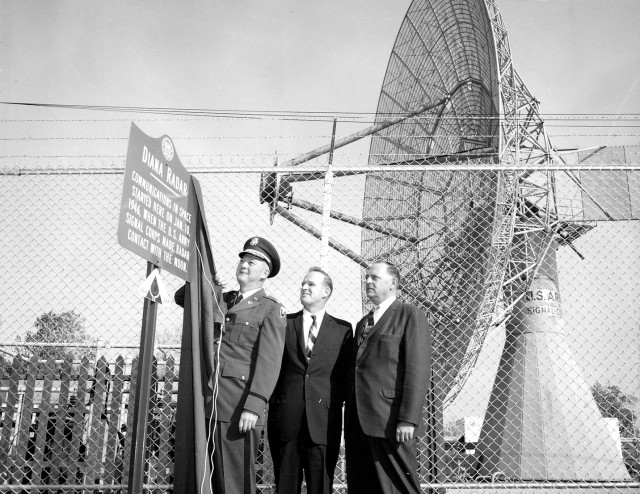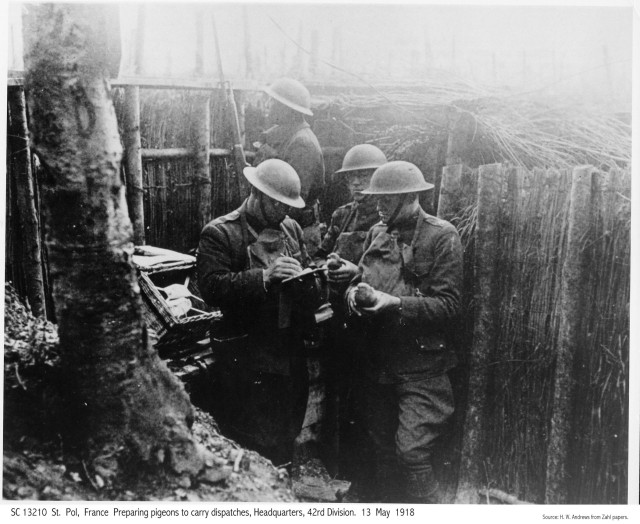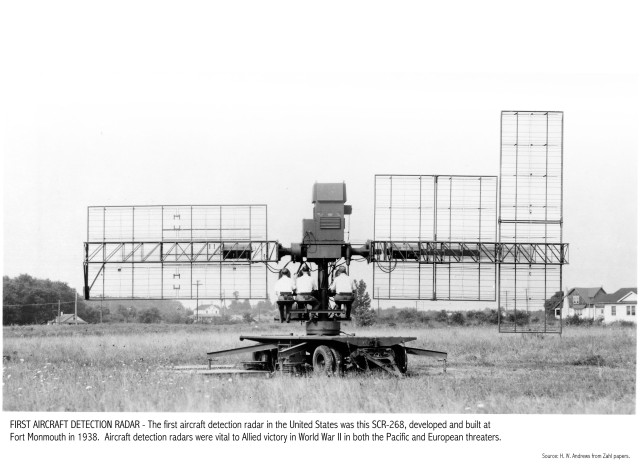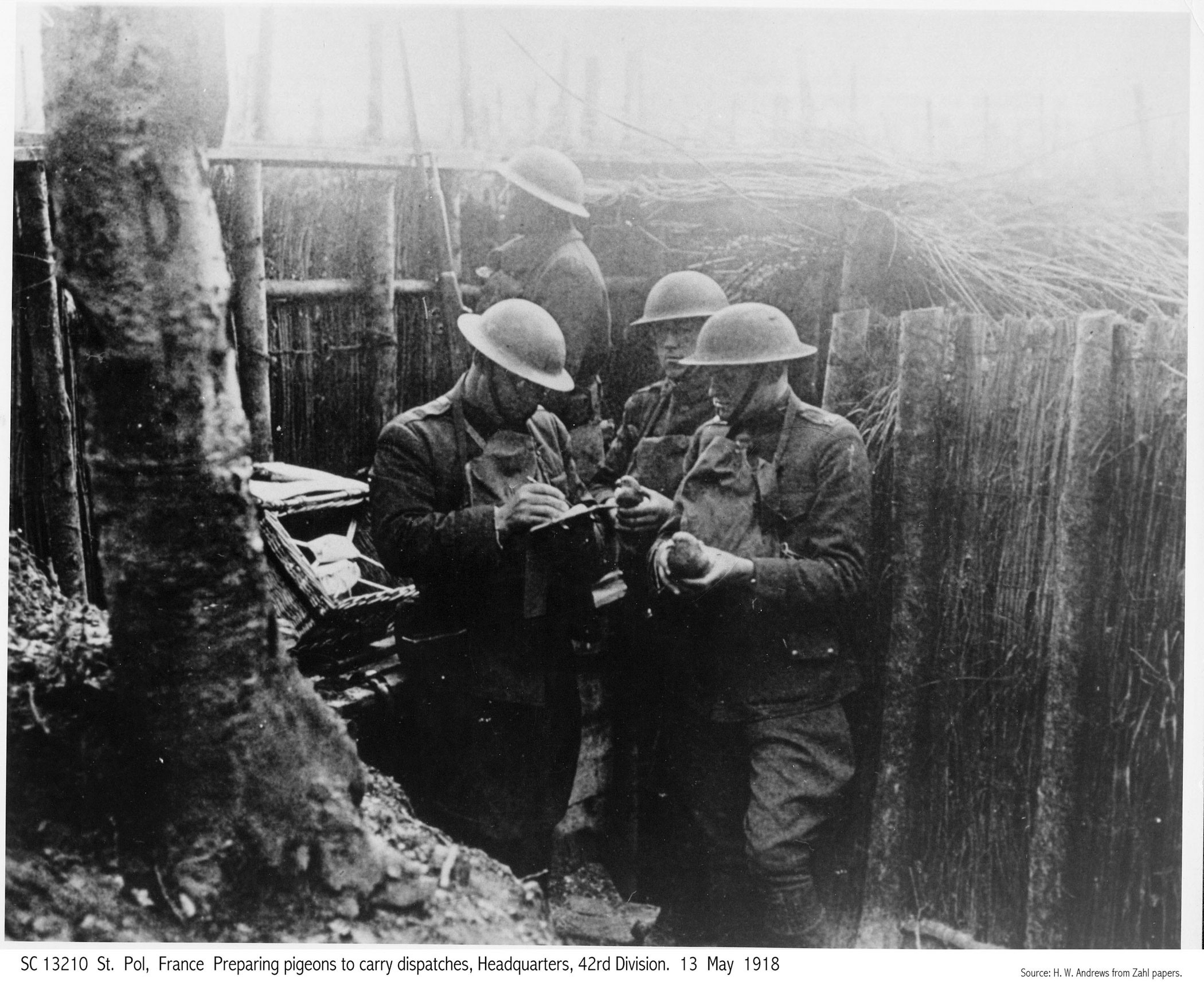(Editor's note: This is part two of a three-part series intended to introduce some of the history of Team C4ISR and its predecessors at Fort Monmouth to the APG community, as well as to those Team C4ISR members who have joined the team at Aberdeen Proving Ground.)
The Signal Corps' Electrical Laboratory of Washington and the Signal Corps' Research Laboratory of New York merged with the Radio Laboratories at Fort Monmouth in 1929 to form the consolidated "Signal Corps Laboratories." The scientists of these labs developed, among many other things, the first U.S. aircraft detection radar.
These radars detected the incoming Japanese planes at Pearl Harbor, and helped to win World War II. Read more at http://www.monmouth.army.mil/historian/pubArtifacts/Articles/2007-09-10_1100-FILE-Fort%20Monmouth%20Invention%20Warned%20of%20Pearl%20Harbor%20Attack.doc.
President Roosevelt's proclamation of a state of "limited emergency" on Sept. 8, 1939, following the outbreak of war in Europe, significantly impacted Fort Monmouth. The Army was immediately authorized additional personnel.
The Signal Corps School curriculum, both officer and enlisted courses, changed to accommodate the increased enrollment.
One year following the "limited emergency" proclamation, Congress passed the Selective Training and Service Act providing for one year of compulsory military training. The President simultaneously called the National Guard into Federal Service, and the Army increased in size yet again.
With the passage of the Selective Service Act, the chief signal officer ordered a Replacement Training Center at Fort Monmouth where enlisted personnel could receive their one year of training. The Signal Corps Replacement Center opened in January 1941 with a capacity of 5,000 men. By December, however, the capacity increased to 7,000 and the one-year training period shrunk to 13 weeks.
Fort Monmouth's other wartime training focused on officer candidates. The Officer Candidate Department activated within the Signal Corps School on June 2, 1941. The first class commenced July 3, 1941. Four hundred ninety students chosen from warrant officers and enlisted Soldiers based on leadership, communications knowledge and prior service comprised that class. A total of 335 newly commissioned second lieutenants graduated after three months of training.
Subsequent classes averaged about 250 men, but gradually grew to 1,000 men per class.
Fort Monmouth received its first contingent of the Women's Army Auxiliary Corps, or WAAC, April 30, 1943, shortly after Public Law 554 on 14 May 1942 granted women the right to serve "with" [not "in"] the Army. The headline of the post newspaper that week read, "Vanguard of WAAC arrives to plan invasion of fort." The article began by exhorting men to straighten their ties and comb their hair, "press those uniforms more carefully than ever because a new impetus has been added to Army life at Fort Monmouth."
A Signal Corps board convened at Fort Monmouth in 1948 eventually contributed to the Army's decision to retain women in peacetime. The board deemed women "more adaptable and dexterous than men in the performance of certain specialties." Read more at http://www.monmouth.army.mil/historian/pubArtifacts/Articles/2007-09-04_0800-FILE-Signal%20Corps_women.doc.
The Signal Corps leased numerous local sites during the war to facilitate Fort Monmouth's expanded missions, to include luxury beachfront hotels and Asbury Park's famed Convention Center (later made famous in part by local legend Bruce Springsteen, and now on both the state and national historic registries). Read more at http://www.monmouth.army.mil/historian/pubArtifacts/Articles/2007-09-04_0800-FILE-Signal%20Corps_women.doc.
Fort Monmouth laboratory development during this period included the SCR-510 in 1941. This early FM backpack radio, a pioneer in frequency modulation circuits, provided front line troops with reliable, static free communications. Multichannel FM radio relay sets (such as the AN/TRC-1) were fielded in the European Theater of Operations as early as 1943. FM radio relay and RADAR, both products of the labs at Fort Monmouth, are typically rated among the top weapon systems that made a difference in World War II.
Wartime training subsided quickly after the cessation of hostilities. Reductions began in May 1943 with orders to inactivate the Replacement Training Center. The center produced more than 60,000 Signal Corps specialists during the 30 months of its existence. Then, in August, the capacity of the Officer Candidate School was set at 150. Classes entered at 17-week intervals. Enrollments fluctuated thereafter. Most of the functions of the Enlisted Department of the Signal School transferred to Camp Crowder, Mo., with the decline in requirements for trained replacements within the Signal Corps. Many expansion facilities leased or purchased during the war were abandoned.
Research in radar technology, however, continued at the Evans Signal Laboratory despite the end of World War II.
The site witnessed a milestone in scientific history on Jan. 10, 1946, when Signal Corps scientists, under the direction of Lt. Col. John J. DeWitt (1906 to 1999), used a specially designed radar antenna (called the Diana Tower) to successfully reflect electronic signals off the moon. The project was named in honor of Diana, Greek goddess of the moon.
The Diana antenna focused a beam of high frequency energy at the moon, traveling at the speed of light (186,000 miles per second). Scientists achieved success shortly after moonrise when an audible ping came over the loudspeaker of their receiver, signaling the return of the radio wave just two and a half seconds later. Continuous recordings were made at regular 2.5 second intervals. The Diana experiment proved the feasibility of communicating across vast distances of space, and newspaper reports at the time put the feat into the same category as the development of the atomic bomb.
Read more about our technological "famous firsts," to include the first weather radar, first weather satellite, first televised weather satellite, first communications satellite and first high capacity communications satellite, at http://www.monmouth.army.mil/historian/pubupdates/FortMonmouthandTeamC4ISRFamousFirsts_Sept2008.pdf.
Although overall military strength decreased rapidly following the end of World War II, the need for trained signal personnel continued throughout the post-war period. Fort Monmouth remained intact as the "Home of the Signal Corps." Personnel strength, however, dropped markedly by January 1948.
Things soon changed as world tensions increased with the Cold War and the Berlin Airlift. Enlarging the capacity of every activity on post again became necessary to sustain the Army's worldwide commitments.
The introduction of Automatic Artillery and Mortar Locating Radars AN/TPQ-3 and AN/MPQ-10 proved to be a major success during the Korean War era.
Other developments of the period included a lightweight field television camera with a back-pack transmitter; a pocket dosimeter for detecting radiation; an ultrasonic quartz saw and super-small experimental field radios.
Advancements in communications systems came so far that in 1957 the Army discontinued the pigeon service, a fixture on post since the end of World War I. Fort Monmouth sold many homing pigeons at auction, while "hero" pigeons with distinguished service records retired to zoos.
Times certainly were changing. Brigadier Gen. Walter E. Lotz, assistant chief of staff for Communications-Electronics, U.S. Army, Vietnam, stated in 1966 that "Electronics has never been so vital in a war as it is here in Vietnam."
The U.S. Army Electronics Command, which was located at Fort Monmouth during the Vietnam War era, supplied much of those electronics. Don't miss that story in next week's APG News.






Social Sharing